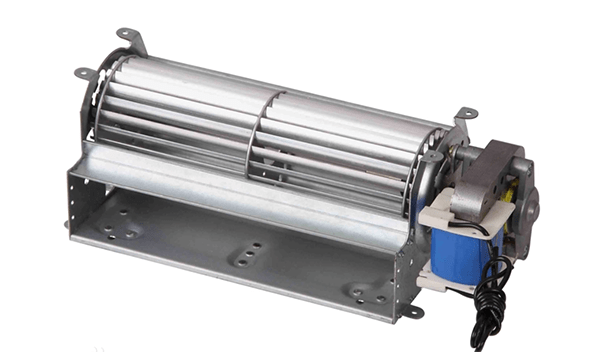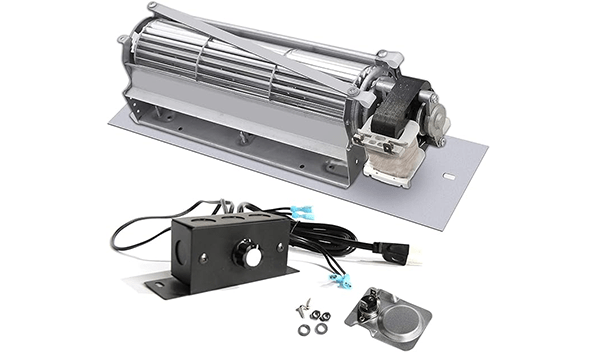Video: Everything You Need to Know About Fireplace Fans and Blowers

Figure 1: Tangential blower.
A fireplace is not only a source of warmth and comfort but also a focal point in many homes. To enhance the efficiency of your fireplace, a fireplace fan or blower can be a valuable addition. In this comprehensive guide, we will explore everything you need to know about fireplace fans and blowers, from their functionality to installation and maintenance.
1. What are Fireplace Fans and Blowers?
Fireplace fans and blowers are devices designed to improve the heat distribution of a traditional wood-burning or gas fireplace. Their primary purpose is to circulate warm air more effectively throughout the room, ensuring that the entire space benefits from the heat generated by the fire.
2. How Does a Fireplace Fan Work?
Fireplace fans / fireplace blowers operate on a simple principle: they help to move the warm air produced by the fire away from the fireplace and into the living space. This is particularly important in large rooms or homes with open floor plans, where heat distribution can be uneven. The fireplace blower is usually installed below or behind the stove, and as it runs, it intakes cool air and pushes the warm air into the room, creating a more comfortable and consistent temperature.

Figure 2: Fireplace air circulation diagram.
3. Types of Fireplace Fans
There are two main types of fireplace fans: manual and automatic.
1.Manual Fans: These fans are operated manually by the user. They typically have a switch or control that allows you to adjust the speed of the fan based on your heating needs.
2.Automatic Fans: These fans are equipped with a thermostat or temperature sensor that automatically activates the fan when the fireplace reaches a certain temperature. This ensures a more hands-free and energy-efficient operation.
4. Benefits of Using Fireplace Fans
1.Improved Heat Distribution: The most significant advantage of using a fireplace blower is the enhanced distribution of heat throughout the room. This can result in more efficient heating and reduced energy costs.
2.Increased Fireplace Efficiency: By circulating warm air, fireplace fans help to maximize the efficiency of the fireplace. This means that more of the heat generated by the fire is utilized, rather than being lost through the chimney.
3.Reduced Heating Costs: With a fireplace fan, you can potentially lower your overall heating costs. By effectively distributing warmth, you may find that you can rely less on other heating sources, saving energy and money.

Figure 3: Fireplace.
5. Fireplace Blower Installation Process
Installing a fireplace fan or blower is a relatively straightforward process, but it's essential to follow the manufacturer's instructions carefully. Here are the general steps for installation:
1.Check Compatibility: Ensure that the fan or blower you choose is compatible with your fireplace model. This information is usually provided by the manufacturer.
2.Locate the Blower Compartment: If your fireplace is designed to accommodate a fan, there will be a designated compartment for the blower. Locate this compartment, which is often situated beneath the firebox.
3.Secure the Fan: Install the fan or blower into the designated compartment, securing it according to the provided instructions. This may involve attaching brackets or screws to hold the fan in place.
4.Connect Power Source: Most fireplace fans require an electrical power source. Connect the fan to the designated power supply, following safety guidelines and local electrical codes.
5.Test the Operation: Before regular use, test the fan to ensure it operates correctly. Check for any unusual sounds or vibrations that may indicate a problem.

Figure 4: Fireplace blower fan kit.
6. Maintenance Tips of Fireplace Fans and Blowers
To ensure the continued efficiency of your fireplace fan or blower, regular maintenance is essential. Here are some tips to keep in mind:
1.Clean Regularly: Dust and debris can accumulate on the fan blades, affecting its performance. Regularly clean the fan blades and surrounding areas to prevent buildup.
2.Check for Obstructions: Ensure that the fan's vents are not obstructed by furniture or other items. Proper airflow is crucial for optimal performance.
3.Inspect Wiring: Periodically inspect the fan's wiring for any signs of wear or damage. If you notice any issues, contact a professional for repairs.
4.Lubricate Moving Parts: Some fireplace fans have moving parts that may require lubrication. Consult the manufacturer's instructions for guidance on lubrication intervals and recommended products.
7. FAQs about Fireplace Fans and Blowers
7.1 How to Do Fireplace Fan Replacement?
To replace a fireplace fan, follow these steps:
1.Turn off Power: Disconnect power to the fireplace and ensure the fan has cooled.
2.Access the Fan: Locate the fan compartment, often beneath the firebox. Remove any covers or panels obstructing access.
3.Disconnect Wiring: Carefully disconnect the wiring from the old fan, noting the connections.
4.Remove Old Fan: Unfasten any screws or brackets securing the old fan. Gently pull it out.
5.Install New Fan: Position the new fan in place, securing it with screws or brackets.
6.Connect Wiring: Reconnect the wiring, matching the old connections.
7.Test Operation: Turn on the power and test the new fan's operation. Ensure it runs smoothly before closing the compartment.
Always follow specific guidelines provided by the manufacturer.

Figure 5: Tangential fan.
7.2 What to Do When Gas Fireplace Fan Not Working?
If your gas fireplace fan is not working, follow these steps:
1.Check Power Supply: Ensure the fan is receiving power. Verify the circuit breaker and switch are on.
2.Inspect Wiring: Examine the fan's wiring for any damage or loose connections. Reconnect if necessary.
3.Clean the Fan: Dust and debris can impede the fan's operation. Clean it carefully, removing any obstructions.
4.Verify the Thermostat: If your fan is thermostat-controlled, check the thermostat settings. Adjust if needed.
5.Consult the Manual: Refer to your fireplace manual for troubleshooting tips specific to your model.
6.Professional Inspection: If issues persist, seek professional assistance to inspect and repair the fan or address any underlying problems.
7.3 Can I Run My Gas Fireplace without the Fan?
Yes, you can run your gas fireplace without the fan. The fan is primarily responsible for circulating warm air throughout the room, but the fireplace itself can still generate heat without it.
Running the fireplace without the fan might result in less efficient heat distribution, particularly in larger spaces. However, it won't harm the fireplace, and you can enjoy the ambiance and warmth it provides. If you prefer using the fan for better heat distribution, ensure it's in good working condition or consider repairing or replacing it.
7.4 How to Do Fireplace Blower Motor Replacement?
To replace a fireplace blower motor:
1.Turn off Power: Disconnect power to the fireplace.
2.Access the Motor: Locate the blower motor. Remove covers or panels obstructing access.
3.Disconnect Wiring: Carefully disconnect wiring from the old motor, noting connections.
4.Remove Old Motor: Unfasten screws or brackets securing the old motor. Gently remove it.
5.Install New Motor: Position the new motor, securing it with screws or brackets.
6.Connect Wiring: Reconnect the wiring, matching the old connections.
7.Test Operation: Turn on power and test the new motor. Ensure it runs smoothly before closing the compartment.
Always adhere to the manufacturer's guidelines for specific instructions.

Figure 6: Fireplace exhaust fan.
8. Conclusion
In conclusion, a fireplace fan or blower can be a valuable addition to your home, enhancing the efficiency of your fireplace and improving heat distribution. Consider incorporating a fireplace fan into your heating strategy to create a more comfortable and inviting living space. O&Kmarts can provide various fireplace fans or blowers / tangential blowers from ebm-papst. If you have any need, please feel free to contact us!



